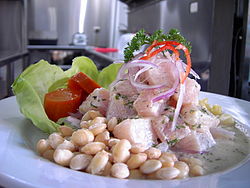 Sangrecita with yuca | |
| Associated cuisine | Peruvian cuisine |
|---|---|
| Main ingredients | Chicken blood |
Sangrecita is a Peruvian cuisine dish of chicken blood. It is seasoned with garlic, onion, chili pepper, herbs and prepared with baked potatoes, fried sweet potatoes or cassava. [1]
